
Logan and Albert Conservation Association

 DID YOU HEAR THAT KOALA LAST NIGHT?
DID YOU HEAR THAT KOALA LAST NIGHT?
A long term resident of Greenbank last night reported hearing the unmistakable calls / grunts of koalas in trees on his property. This information was relayed to me less than 40 minutes after the noisy koala. Evidence available to us that koalas are NOT locally extinct in Greenbank . We were both attending the SAVE GREENBANK CAMPAIGN meeting 23 February2011
If we can prove that our resident Greenbank Jimboomba Flagstone koalas are alive and well we will have a greater chance of delaying inappropriate development.
Many of us have resident koalas that we see but do not report. Please report your sightings to LACA president Anne Page mkpage@bigpond. We have arranged to have our wildlife sightings accepted by DERM and ULDA.
SPOTTED TAILED QUOLL have also been seen in the area. We need to update that data also. GLOSSY BLACK COCKATOOS are another significat species. While all species are important to the survival of the habitat humans also need to have a healthy lifestyle, the more iconic species named carry greater levels of protection.
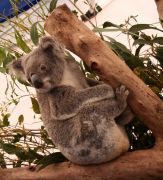 TAKE ACTION FOR OUR WILDLIFE TODAY
TAKE ACTION FOR OUR WILDLIFE TODAY
The biodiversity of SEQ is threatened - and that includes we humans. Our wildlife species need the humans who co-exist with them enjoying the same ecosystem services as the wildlife to speak up and contact the governing authorities.
We need each other to continue to enjoy our healthy lifestyle that is so popular. However, if you do not reduce our damaging impact on the natural environment, then we will destroy what we love. If we do not all tell governments that their planning is inadequate then we will lose our iconic and state emblem - the koala - except perhaps for those born in captivity who are unable to survive in natural bushland areas - like Freckles.
FRECKLES pictured aside attended Logan's LEAF event 2010. She is an ambassador to alert us to the plight of all koalas - especially those in SEQ and in all ULDA areas - Greenbank, North Maclean, Flagstone, New Beith, Yarrabilba, Undalla, Ripley and the whole Scenic Rim area which has other threats - mining and quarrying to support the huge population coming our way. CANBERRA was not planned in 6 months. Business as usual is no longer an option. Consultants for the high density housing proposal at Greenbank suggest that our local koalas are already extinct?
WE know that is not true because we see and hear koalas throughout our area.
WE HAVE TO PROVIDE THE DATA TO ULDA and DERM SO THAT THEY ARE ABLE TO UPDATE ENVIRONMENTAL BACKGROUND STUDIES AS THEY NOW EXIST
Please send your information to LACAs President This email address is being protected from spambots. You need JavaScript enabled to view it. so we can collate and forward to ULDA and DERM.
Go through all of your photos so we can produce a gallery of our local wildlife and add to our submissions
Come along to the next public meetings - every Wednesday at Greenbank www.save.greenbank.com.au for details.
 Greenbank citizens win extension - until 15 March 2011
Greenbank citizens win extension - until 15 March 2011
Greenbank community residents held its second meeting Wednesday 16 February 2011. State member for Lockyer IAN RICKUSS MP attended both meetings and urges all citizens to use the power of the people to gain the attention of the state's political leaders.
Channel 7 News provides coverage Thursday 17 February 2011 news.
We were delighted to hear that his representation on community behalf has granted us a two week extension to be better abled to make more and more detailed submissions to ULDA about the Teviot Downs Estate development proposal. Submissions are now due 15 March 2011.
There have been no wildlife surveys conducted by the developer / consultant or ULDA. Development application documents suggest that
koalas in Greenbank area are locally extinct.
RESIDENTS OF GREENBANK FLAGSTONE JIMBOOMBA NORTH MACLEAN CHAMBERS FLAT CEDAR GROVE
know this is NOT TRUE.
We know because we see them, hear them, and have seen and heard them, for many years. However if we have not sent in sightings of wildlife to DERM Department of Environment and Resource Management, that data is not available when desktop studies are done.
Spotted tailed quolls have also been confirmed as being in our area - but not listed in the environmental report for the development. Dr Scott Burnett did a study for Beaudesert Shire Council pre amalgamation. LACA and its members contributed to funding this study - but it is not available to the general public.
Why not? Who owns the study? Is it with other publically funded studies we are unable to access - even with RTI Right to Information process.
If you have not already sent your wildlife sightings in to DERM - or don't know how - contact LACA president Anne Page next meeting 23 February and record your sightings - to be sent to DERM.
Shadow Minister for Planning Lawrence Springborg also attended the public meeting. His advice is for all residents to contact their political representatives and have all extended family and friends to raise this ill-planned proposal with their political representatives. The politicans have the power to change the regulations.
Our job is to make sure they hear what we are saying. Take action. Sign the petition to be tabled in parliament.
Send in a properly made submission. Attend meetings arranged by http://www.savegreenbank.com.au/
Save our local wildlife from extinction. We are all in the one boat. We all benefit from and need the natural environment.
KOALA SIGHTINGS (Browns Plains to Veresdale Scrub, Yatala to Ipswich City)
T he koala sightings in the map shown (click to enlarge) have been reported to WILDNET (Department of Environment and Resource Management) by the community and other scientific experts, and are current to June 2009 and include historically observations as well. The koala population in the Mount Lindesay North Beaudesert area have NEVER been properly surveyed by any local council or by state government and these WILDNET sightings provide very valuable information for the local area when no other detailed studies have been undertaken.
he koala sightings in the map shown (click to enlarge) have been reported to WILDNET (Department of Environment and Resource Management) by the community and other scientific experts, and are current to June 2009 and include historically observations as well. The koala population in the Mount Lindesay North Beaudesert area have NEVER been properly surveyed by any local council or by state government and these WILDNET sightings provide very valuable information for the local area when no other detailed studies have been undertaken.
LACA encourages the community to continue to report their valuable wildlife sightings from their local area or from other areas the community may visit.
PROPOSED ENERGEX POWERLINE ROUTE - CAMP CABLE RD / WATERFORD-TAMBORINE RD /
LOGAN RIVER / LOGAN RESERVE RD and KOALAS
This WILDNET map reveals that there are numerous sightings of koalas to the north and south of Camp Cable Rd and east and west of Waterford -Tamborine Rd. RSPCA and residents have reported collecting dead and injured koalas from the vicinity of the new Camp Cable Rd and surrounding areas. There are already existing cleared easements for Powerlink easements ( north of Camp Cable Rd) and Energex easements (south of Camp Cable Rd) that create barriers for koala movement and increase the length of time that koalas may spend moving over open ground and therefore place koalas at greater risk of cars and dog attack. Local residents along Camp Cable Rd have already noted a decline in visits by native animals as a result of the construction of the new alignment for Camp Cable Rd a few years ago. Energex's own IAR report from June 2009 acknowledges that current powerline easements already fragment habitat and this proposed route will continue to fragment and degrade the habitat further with further negative impacts on local and regional significant fauna species such as koalas.
Our first South East Queensland Koala Alliance video is ‘in the can’ and can be viewed at this link here. 
http://www.youtube.com/user/sbaltais#p/a/u/0/WT_DDDEvjHE
A group of concerned citizens from Logan have been engaged and actively campaigning to protect the Logan River from the first unsustainable proposal by ENERGEX to supply power for goverment's stated future population growth. The group VETO have a website www.veto.org.au which is currently being updated. There have been many sightings of koalas along the proposed power corridors. It would seem the big squeeze is being exerted on all species of the natural environment - animals and plants,microbes and man - to move over for the built environment with its manufactured concrete and steel structures.
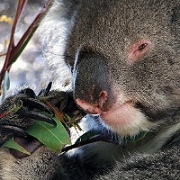 Modern koalas - the sole living member of the diprotodontian marsupial family Phascolarctidae - are among the largest of all arboreal leaf-eaters. To attain this remarkable condition on a diet of eucalyptus leaves, a notoriously poor and somewhat toxic food source, the tree-dwelling marsupials developed unique anatomical and physiological adaptations including specialized chewing and digestive anatomies and a highly sedentary lifestyle. The dramatic differences between the skulls of extinct and modern koalas, especially in the facial region, are probably related to the change to a tougher diet of eucalyptus leaves.
Modern koalas - the sole living member of the diprotodontian marsupial family Phascolarctidae - are among the largest of all arboreal leaf-eaters. To attain this remarkable condition on a diet of eucalyptus leaves, a notoriously poor and somewhat toxic food source, the tree-dwelling marsupials developed unique anatomical and physiological adaptations including specialized chewing and digestive anatomies and a highly sedentary lifestyle. The dramatic differences between the skulls of extinct and modern koalas, especially in the facial region, are probably related to the change to a tougher diet of eucalyptus leaves.
This research has recently been reported at www.physorg.com - from the new findings published as the featured cover article in the current issue of The Journal of Vertebrate Paleontology.
Skull fragments of prehistoric koalas from the Riversleigh rainforests of millions of year ago suggest they shared the modern koala's "lazy" lifestyle and ability to produce loud "bellowing" calls to attract mates and provide warnings about predators but did not share the uniquely specialized eucalyptus leaf diet of the modern koala (Phascolarctos cinereus).
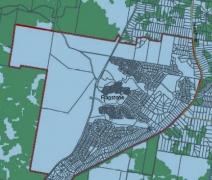 New koala planning provisions will be introduced in December 2009 and comprise:
New koala planning provisions will be introduced in December 2009 and comprise: New koala conservation state planning regulatory provisions: the Proposed South East Queensland Koala Conservation State Planning Regulatory Provision ( 746 KB 38p) and proposed koala habitat mapping that will regulate new development in koala habitat areas. You can access the several area maps from this dip page http://www.dip.qld.gov.au/maps/seq-koala-habit-regulatory-maps.html
Map 24 http://www.dip.qld.gov.au/resources/map/koala-regs/koala-sprp-maps-24.pdf does not show any koala habitat in the Flagstone area? Difficult to believe - if you see all the surrounding habitat? http://www.dip.qld.gov.au/resources/map/koala-regs/proposed-seq-koala-conservation-seqkc-map-24.pdf
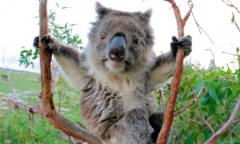
Monday 23 November 2009 British online edition of The Guardian reported on the ongoing battle being fought for many years to protect Australia's iconic koala by the koala campaigners from the Australian Koala Foundation, scientists, conservation and wildlife care groups and concerned citizens . Journalist Gideon Haigh presented the situation.
Tuesday 10 November 2009 in Canberra, representatives of the Australian Koala Foundation (AKF) took a long and determined campaign for better protection of the creature to the government's "threatened species scientific committee", following a request for a review of the animal's status by environment minister Peter Garrett. The foundation presented what they say is definitive evidence of a sharp decline in koala numbers due to habitat destruction and disease. Its message was stark: the koala would be extinct "within 30 years". Hits on its website instantly doubled, and concerns were expressed about the impact on Australia's tourist industry: polls consistently show the koala to be the country's most popular animal with visitors.
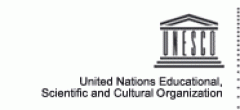 This week, the Noosa Biosphere is launching their new web site, described as an active place for community, special interests and visitors to connect with a broad range of biosphere reserve activity, with Michael Donovan, the Inaugural Chair of the Noosa Biosphere describing the web site as, "Punk in nature but logical in delivery and a striking example of creativity, commitment and practical outcomes from a locally based business".
This week, the Noosa Biosphere is launching their new web site, described as an active place for community, special interests and visitors to connect with a broad range of biosphere reserve activity, with Michael Donovan, the Inaugural Chair of the Noosa Biosphere describing the web site as, "Punk in nature but logical in delivery and a striking example of creativity, commitment and practical outcomes from a locally based business".
The Noosa Biosphere Reserve is also hosting a visit this week from Dr Natarajan Ishwaran, the UNESCO Secretary to the Man and the Biosphere Programme and Director of Earth Sciences, with over the two days of Dr Ish's visit, the hosting a Biosphere Q&A session and today the official launch of the Noosa Biosphere Reserve website www.noosabiosphere.org.au launch and a short film produced in Noosa.
Noosa, as Queensland's first UNESCO Biosphere is all about promoting harmony between people and nature through education, conservation and sustainable activities - all of which have a direct impact on the quality of Noosa as a tourism destination.
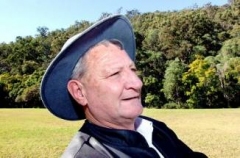 Environmentalists and concerned citizens are dismayed at lack of foresight by state government and local councils which blindly accept SEQRP urban footprint proposals.
Environmentalists and concerned citizens are dismayed at lack of foresight by state government and local councils which blindly accept SEQRP urban footprint proposals.
Ted Fensom, pictured aside, has been campaigning, and continues to campaign to assist local communities to protect what remains of open space, natural habitats and bioregional corridors, good quality agricultural lands, wetlands and riverine vegetation. Many of our rare and threatened fauna species depend of these patches of disconnected fragmented bushlands.
Glenn Leiper's presentation at the community meeting held at Windaroo Valley high school 5 November 2009 highlighted the rare and threatened and newly discovered plant species that are part of Bahrs Scrub biodiversity. Information about these rare flora will be added soon.
Albert and Logan news reported our concerns in July this year. Story is repeated here.
Or you can search the archives here